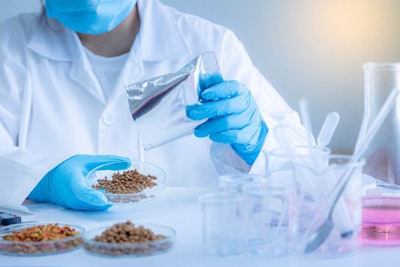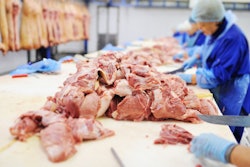
Jarrod Kersey of Simmons Pet Food discusses ways to ensure animal health and well-being in the animal feed and pet food industries
PODCAST: Keys to ingredient safety, quality (10:43)
Ann Reus: Hello and welcome to the Feed Strategy podcast. I’m your host, Ann Reus.
Jarrod Kersey is the vice president of quality and government affairs for Simmons Pet Food. He will also be a featured speaker at Petfood Essentials, part of Petfood Forum, which will be presented by WATT Global Media and Petfood Industry this September in Kansas City. There, he will discuss traceability and testing of ingredients and best practices to guard against pathogens such as Salmonella and other contaminants including mycotoxins, heavy metals and pesticides and herbicides.
Jarrod, welcome to the podcast.
Jarrod Kersey: Thank you for having me.
Reus: Can you give a little sneak peek at the topics you plan on discussing at Petfood Essentials? And why should those who work in the industry be concerned about these topics?
Kersey: So honestly, my thought was, I’d like to kind of talk about how you build a food safety program, you know, there’s a lot of things to think about. And you know, people go to the low-hanging fruit oftentimes with just basic GMPs, and so forth. And those are very important, they should be the foundation of everything you have. But you know, it takes more nowadays than before. So, knowledge of ingredients and understanding what you should be looking for and sampling plan and partnerships are increasingly important to make sure that you have the right quality and food safety in your ingredients that are coming in. So in short, I’m going to kind of go through how you build it, what you need to be thinking about. And I don’t claim to know everything about food safety, I would tell you that you need to understand that there’s a lot of areas of expertise that go into a total food safety program, and no one person is going to know everything about all subjects.
Reus: Now, I usually talk about livestock and poultry feed on this podcast, but today we’re talking pet food. Quality and safety are obviously very important for all of these species. What are some aspects of safety and quality that are important across feed and pet food?
Kersey: Well, the principles are very much the same. Animal health and well-being is critical to both industries and they use many of the same raw materials, and so forth, go into these. When I first started out in the industry, I worked in cottonseed. And for instance, our cottonseed meal and whole cottonseed went into dairy and feedlots. And so you start to learn things like gossypol. Now, while you wouldn’t feed cottonseed or cottonseed meal to a pet, there are equivalent things, like aflatoxins, and fumonisins and vomitoxins and things that you’re going to want to be looking out for pet and in the livestock industry. And so the sampling programs and things like that are very much the same. I think what is different is that there’s a lot of times a very, very wide diversity of probably more human-like ingredients that go into some pet food products, depending on the format. But realistically, the answer is animal health and well-being. I don’t care whether you’re making pet food or you’re making food for chickens, you have very strong interest in both of those and making sure that you’re taking the best care for the animals that you can.
Reus: What are some things that are unique to each of these industries? For example, are there different risks present in the feed mill versus at a pet food facility?
Kersey: Well, a lot of times I explain to people, they ask, because I didn’t start out in the industry working in pet food, but 21 years ago, I quickly made the jump over to pet food and pet food is a CPG, it’s a consumer product good. Meaning people go into the store or nowadays they go online, and they select a specific product. And one of the biggest things that I had to wrap my mind around was that that drives a very different behavior than dealing with a family farm or integrated poultry operation or anything. That’s an individual consumer making these choices. And then one thing you learn very quickly is that, because of that, it goes into the kitchen. You know, if we look back historically, FDA started sampling tests for micros in finished pet food because they saw that it was going into the homes and into the kitchen specifically. And, and so therefore, that’s one of the big differences. So GMPs and maintaining clean facilities and understanding your process and having efficient, good processes within a feed mill or a pet food facility are absolutely critical. But I would say that your focus on the micros in a particularly in a dry pet food facility is probably a step change between those two.
Reus: What are some of the biggest elements that can sacrifice ingredient quality or safety and what are some best practices to mitigate these risks?
Kersey: I would say understanding the ingredient and the risk, understanding variability. When I talk about making quality, safe pet food, it’s having knowledge that what is coming in is consistently what it needs to be. So when you have identification of what your risks are. So, for instance, if I’m looking at corn and aflatoxins, what does my sampling plan need to be? Where do I get my product from? What is the supplier doing? How are you partnering in those? I think it’s important that you have a plan. And you don’t have to be the expert, like I said. You don’t have to know everything about ochratoxin or zearalanone or any of the number of compounds that could be of interest, but you do need to know, should you be asking that question? And should you be testing or sampling or in some way ensuring that you are not putting yourself at risk and taking care of the animals that we’re trying to care for.
Reus: As you mentioned, you’ve worked in this industry a long time. How have you seen the regulatory environment and levels of quality control evolve, and do you think there’s still more room for improvement?
Kersey: I love the question, and I’ll tell you why, because I routinely lecture at different universities for students, and everybody always wants to hear a regulatory lecture. And it’s actually my favorite topic on this because we kind of, in my career, I feel like a kind of watch modern history unfold in working both at trade associations where you’re in the promulgation process of the rules with the agency and then in the industry, where you are living with those. And what I will say is this is, 2007 was a monumental year and a shift in in food safety in this country. And probably one of the biggest catalysts for change came about that year. If you start off in January of that year, we had a little thing called Peanut Corporation of America. By the time March rolled around melamine had popped up and by the time September hit, Congress had passed the (Food and Drug Administration Amendments Act or FDAAA) and really started the ball rolling, and then ultimately FSMA, the Food Safety Modernization Act, rolled out of everything. But yes, I would tell you that there were times when I first got in the industry that you would come across smaller firms that really had no food safety program. Sure, they followed some GMPs, because you have to do some of that to operate. But it’s been a monumental shift in the last, I guess I’ve been doing this now for 23 years in the industry, and working closely with government, it’s been a huge change. And you know, largely, Ann, it’s been driven by the consumer. The consumer, as you know, what the consumer knows and believes and trusts and the speed at which it travels today is far different than it was 23 years ago when I first came into the industry. So yeah, for what it’s worth, I would say that things have changed greatly. I think they have, we’ve greatly improved, we’ve done it because consumers demand it and it’s the right thing to do. And I would say that we’ll continue to get better. We’ve set that bar that consumer is boss now and I think it’s going to continue to grow that way.
Reus: Well thank you, Jarrod, for these insights. You can hear more from Jarrod Kersey at Petfood Essentials, part of Petfood Forum. Petfood Forum will be held in person in Kansas City from September 22 through the 24th, with virtual sessions available on demand from September 27 until December 31. For more information, go to PetfoodForumEvents.com. Thanks for listening, and we hope to see you in Kansas City.















